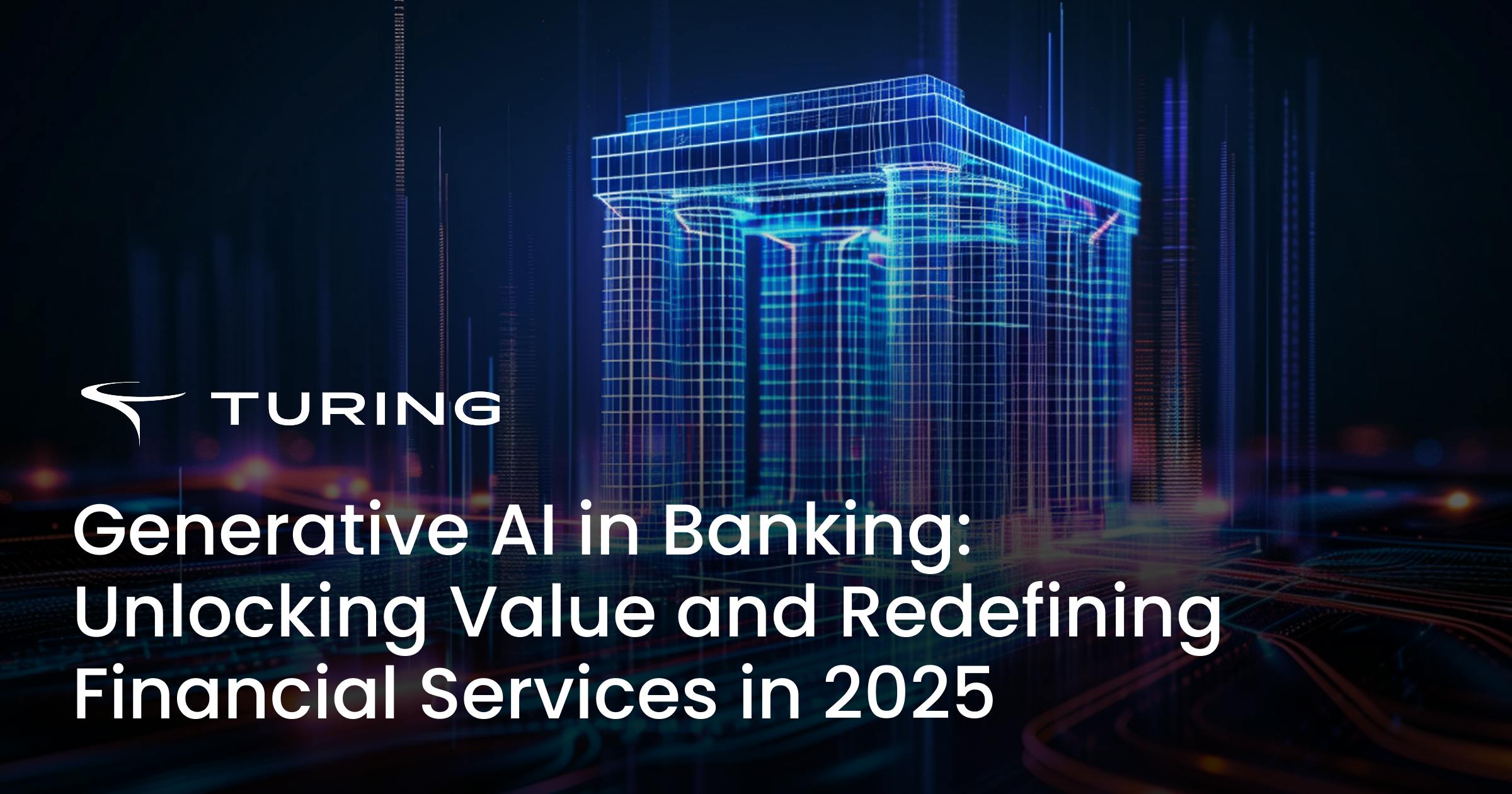Generative AI in Banking: Unlocking Value and Redefining Financial Services in 2025

MG Stephenson
•7 min read
- GenAI

This rapid adoption of generative AI is transforming banking at a pace few could have predicted. More than just automating tasks, GenAI has the potential to reimagine how financial firms operate, engage with their customers, mitigate risk, and unlock entirely new revenue streams.
As digital-native competitors and shifting customer expectations pressure traditional players, the use of generative AI in banking has evolved from a mere curiosity into an engine for competitive advantage.
Banking leaders recognize that the institutions best equipped to succeed in the next decade will be those that integrate GenAI capabilities at the core of their operations. According to a 2024 EY report, 95% of banking executives believe GenAI will significantly change how their organizations operate in the next three years.
In parallel, customer expectations are evolving. More users now expect on-demand, personalized digital experiences akin to what they receive from retail tech giants. GenAI helps bridge this experience gap, enabling banks to deliver intuitive, human-like interactions at scale while also maintaining rigorous compliance and risk standards.
What is Generative AI in banking?
Generative AI refers to a class of machine learning models that can create new content—text, images, code, or even data—based on patterns learned from large datasets. In banking and financial services, GenAI models such as GPT (Generative Pretrained Transformers) can analyze complex datasets, generate natural language outputs, and deliver contextual responses in real time.
Unlike traditional AI, which is designed primarily to classify, predict, or automate fixed tasks, GenAI is dynamic. It adapts to inputs and can generate insights or responses in a conversational, context-aware manner. This makes it particularly valuable for industries like banking, where precision, personalization, and scale are critical.
Additionally, large language models (LLMs) trained on financial corpora can parse legal contracts, generate summaries of quarterly reports, and even draft responses to regulatory inquiries—all within seconds. This capability enables banking institutions to reduce the overhead of repetitive knowledge work, freeing up skilled personnel to focus on higher-value tasks.
Why is Gen AI in banking important?
The financial services industry is ripe for disruption. Rising operational costs, tightening regulations, evolving customer expectations, and intensifying competition are forcing banks to do more with less. Generative AI offers a powerful lever to:
- Reduce costs through intelligent automation
- Improve customer experience via personalized interactions
- Accelerate innovation in product and service design
- Enhance risk management by processing vast data volumes
- Enable faster decision-making with real-time insights
According to Accenture, banks that aggressively adopt GenAI at scale could boost productivity by 30-40% in certain functions and reduce operational costs by up to $300 billion across the industry.
For instance, traditional KYC (Know Your Customer) compliance checks, which can take days or even weeks, are being streamlined through GenAI's ability to extract and validate customer identity information from documents in real time. This not only improves onboarding speed but also reduces the risk of human error and regulatory non-compliance.
Generative AI use cases in banking
How is GenAI used in banking? Let’s take a look at:
Customer Service Automation
GenAI-powered chatbots and virtual assistants are transforming how banks engage with customers. These tools can handle complex queries, provide 24/7 support, and even detect customer sentiment to adjust tone and content dynamically. For example, AI copilots can assist call center agents by suggesting context-relevant responses in real time.
In some implementations, AI agents have resolved up to 60% of customer queries without human intervention, significantly lowering support costs while improving resolution times. These systems also learn and improve from every interaction, creating a virtuous cycle of efficiency.
Fraud Detection and Risk Analysis
Generative AI models can simulate fraudulent patterns and adversarial attacks to improve fraud detection systems. These simulations enhance model robustness and enable early threat detection. GenAI also supports risk analysis by summarizing dense documents, identifying anomalies, and producing audit-ready reports.
Some banks are leveraging GenAI to automatically flag unusual transaction patterns, generate alerts, and suggest preventive actions. The combination of predictive analytics with generative modeling enables proactive, rather than reactive, fraud management.
Personalized Marketing and Product Recommendations
Banks can use GenAI to analyze transaction data and customer behavior to generate hyper-personalized offers and communications. By tailoring content to individual preferences, banks can drive higher engagement and conversion rates.
For example, a bank might generate a customized credit card offer based on a customer’s travel habits, spending patterns, and life stage, improving the likelihood of conversion. These insights can be automatically surfaced through CRM systems powered by GenAI.
Regulatory Compliance and Document Summarization
GenAI tools can parse and summarize lengthy regulatory documents, assess compliance risk, and assist with policy interpretation. This significantly reduces the manual burden on compliance teams and speeds up response times.
In a highly regulated environment, GenAI can help institutions stay ahead of new regulations by generating alerts and summaries of updates from global financial authorities, reducing compliance lag and boosting institutional agility.
Code Generation and IT Modernization
Software development teams in banks are using GenAI to accelerate code generation, refactor legacy codebases, and produce documentation. This supports digital transformation efforts by improving time-to-market and system agility.
Wealth and Investment Advisory
AI-powered advisors can generate portfolio insights, market summaries, and investment recommendations tailored to client profiles. These tools help relationship managers scale their capabilities while maintaining personalization.
Wealth management firms are increasingly using GenAI to simulate investment scenarios under different macroeconomic conditions, helping clients make informed decisions while providing clear, digestible summaries of risks and returns.
Credit Risk Assessment and Loan Underwriting
By ingesting structured and unstructured data from various sources, GenAI models can assist underwriters in making faster, more accurate credit decisions, especially in small business and consumer lending.
Implementing GenAI in Banking
To realize the benefits of generative AI in banking, financial institutions must take a structured and strategic approach to implementation. Key steps include:
- Identify High-Impact Use Cases
- Banks should start with areas where GenAI can deliver tangible ROI, such as customer service or document processing. A clear prioritization framework is critical.
- Establish a Governance Framework
- Effective GenAI use requires robust governance to manage data privacy, ethical use, hallucination risks, and compliance with evolving regulations like the EU AI Act and U.S. AI policy frameworks.
- Invest in the Right Infrastructure
- Deploying GenAI models requires scalable infrastructure, such as cloud-based GPU instances and robust data pipelines. Partnerships with cloud providers and AI platforms can accelerate this setup.
- Upskill Teams and Build Internal Capability
- Banks should invest in training programs for business and technical staff to improve AI fluency. Cross-functional GenAI task forces can ensure alignment between business goals and technical implementation.
- Embed AI into Core Processes
- Rather than treating GenAI as a bolt-on solution, banks should integrate AI into existing workflows and platforms to maximize adoption and productivity.
Challenges of Using GenAI in Banking
Despite its promise, generative AI presents several challenges that banks must address to ensure safe and effective deployment.
Data Privacy and Security
Handling sensitive customer and financial data requires strict adherence to privacy laws and cybersecurity standards. GenAI systems must be designed to protect data and ensure traceability.
Model Hallucination and Accuracy
Unlike traditional AI, GenAI models can sometimes generate plausible but incorrect outputs—a phenomenon known as hallucination. This can lead to erroneous financial advice or compliance breaches if unchecked.
Mitigation strategies include grounding outputs in verified internal data, using retrieval-augmented generation (RAG) systems, and applying prompt engineering techniques that reduce ambiguity.
Regulatory Uncertainty
The legal and regulatory landscape for GenAI is evolving. Banks need to stay ahead of global regulations and implement mechanisms to ensure explainability, accountability, and transparency in AI outputs.
Integration with Legacy Systems
Many banks operate on outdated infrastructure. Integrating GenAI tools into legacy systems can be costly and technically complex without a broader modernization roadmap.
Ethical and Bias Concerns
Bias in training data can lead to discriminatory outputs. Banks must audit models regularly and ensure fairness, particularly in sensitive areas like lending, fraud detection, and hiring.
Future of Generative AI in Banking
The future of generative AI in banking is not just about automation—it’s about augmentation. As the technology matures, banks will increasingly rely on GenAI to:
- Deliver real-time financial coaching and education via AI advisors
- Co-create products with customers by generating personalized offerings on demand
- Accelerate mergers and acquisitions with GenAI-assisted due diligence
- Drive hyper-automation of back-office functions and compliance tasks
- Predict and simulate economic scenarios to inform risk strategies
According to Google Cloud, over 80% of banking leaders expect AI to be a critical differentiator in the next five years, especially in improving customer experience and operational efficiency.
As GenAI becomes embedded in every banking layer—from the front office to the back end—future institutions may evolve into AI-native organizations. These will be capable of adapting to market shifts in near real-time, rapidly prototyping services, and continuously learning from interactions at scale.
In the long term, GenAI could even reshape the industry’s operating model—from vertical integration to platform-based, partner-driven ecosystems where AI serves as the connective tissue.
From POC to Proving Value
The use of AI in the banking sector is no longer a futuristic vision—it’s a competitive necessity. By strategically implementing GenAI across high-impact areas, banks can unlock significant value, streamline operations, and better serve customers in a rapidly evolving digital world.
While challenges exist, the institutions that adopt a proactive, ethical, and well-governed approach to generative AI will be best positioned to lead in the next era of financial services.
The future belongs to those who don’t just deploy AI—but who fundamentally reimagine what banking can become with it.
AI That Executes, Not Experiments
Still stuck in pilot purgatory? Turing’s Agentic Ops framework deploys AI agents directly into your KYC, claims, and underwriting workflows—cutting cycle times by up to 80% and proving ROI in weeks, not quarters.
→ Talk to a Turing Strategist
Author
MG Stephenson
MG is a skilled technology writer & content marketer with over a decade of experience in the B2B SaaS space. MG specializes in translating complex technical topics into broadly digestible stories that bridge the gap between developer and business teams.
